A Content and Sentiment Analysis of Greek Tweets during the Pandemic
Abstract
1. Introduction
- RQ1: To what extent did the Greek Twitter sphere react during the first wave of the Covid-19 pandemic?
- RQ2: What are the main topics discussed and which are the most important keywords that emerged through these discussions?
- RQ3: What was the general sentiment of the people during this period?
2. Social Media and Discussion Topics during the Pandemic
3. Sentiment Analysis and Emotion Understanding during the Pandemic
3.1. Sentiment Analysis in the Literature
3.2. Twitter Sentiment Analysis
3.3. Sentiment Analysis of COVID-19 Tweets
4. Methodology
5. Results
5.1. Answering the Research Questions
5.2. Macroscopic Analysis
5.3. Sentiment Analysis
6. Discussion
7. Conclusions—A View Ahead
Author Contributions
Funding
Institutional Review Board Statement
Informed Consent Statement
Data Availability Statement
Conflicts of Interest
References
- Alqurashi, S.; Alhindi, A.; Alanazi, E. Large Arabic Twitter Dataset on COVID-19. arXiv 2020, arXiv:2004.04315. [Google Scholar]
- Chen, E.; Lerman, C.; Ferrara, E. Tracking Social Media Discourse About the COVID-19 Pandemic: Development of a Public Coronavirus Twitter Data Set. JPHS 2020, 62, e19273. [Google Scholar] [CrossRef] [PubMed]
- Covid: How Are European Countries Tackling the Pandemic? Available online: https://www.bbc.com/news/explainers-53640249 (accessed on 7 March 2021).
- Jobs and Economy during the Coronavirus Pandemic. Available online: https://ec.europa.eu/info/live-work-travel-eu/coronavirus-response/jobs-and-economy-during-coronavirus-pandemic_en (accessed on 7 March 2021).
- Drouin, M.; McDaniel, B.T.; Pater, J.; Toscos, T. How Parents and Their Children Used Social Media and Technology at the Beginning of the COVID-19 Pandemic and Associations with Anxiety. Cyberpsychol. Behav. Soc. Netw. 2020, 23, 727–736. [Google Scholar] [CrossRef]
- Yan, Y.; Zhou, R.; Gao, X.; Chen, G. Predicting Content Popularity in Social Networks. In Big Data in Complex and Social Networks; Thai, M.T., Wu, W., Xiong, H., Eds.; CRC Press: Boca Raton, FL, USA, 2016. [Google Scholar]
- Rufai, S.R.; Bunce, C. World leaders’ usage of Twitter in response to the COVID -19 pandemic: A content analysis. J. Public Health 2020, 42, 510–516. [Google Scholar] [CrossRef] [PubMed]
- European Commission. Policy Measures Taken against the Spread and Impact of the Coronavirus. 14 May 2020. Available online: https://ec.europa.eu/info/sites/info/files/coronavirus_policy_measures_14_may_1.pdf (accessed on 4 December 2020).
- Liu, B. Sentiment Analysis. In Sentiment Analysis: Mining Opinions, Sentiments, and Emotions (Studies in Natural Language Processing); Cambridge University Press: Cambridge, UK, 2020. [Google Scholar]
- Manyika, J.; Chui, M.; Brown, B.; Bughin, J.; Dobbs, R.; Roxburgh, C.; Hung Byers, A. Big Data: The Next Frontier for Innovation, Competition, and Productivity. 1 May 2011. Available online: https://www.mckinsey.com/business-functions/mckinsey-digital/our-insights/big-data-the-next-frontier-for-innovation#:~:text=The%20amount%20of%20data%20in%20our%20world%20has,research%20by%20MGI%20and%20McKinsey%27s%20Business%20Technology%20Office (accessed on 29 May 2021).
- Stai, E.; Karyotis, V.; Katsinis, G.; Tsiropoulou, E.E.; Papavassiliou, S. Hyperbolic Big Data Analytics within Complex and Social Networks. In Big Data in Complex and Social Networks; Thai, M.T., Wu, W., Xiong, H., Eds.; CRC Press: Boca Raton, FL, USA, 2016. [Google Scholar]
- Stai, E.; Kafetzoglou, S.; Tsiropoulou, E.E.; Papavassiliou, S. A holistic approach for personalization, relevance feedback & recommendation in enriched multimedia content. Multimed. Tools Appl. 2018, 77, 283–326. [Google Scholar]
- Rambocas, M.; Gama, J. Marketing Research: The Role of Sentiment Analysis. In The 5th SNA-KDD Workshop’11; University of Porto: Porto, Portugal, 2013. [Google Scholar]
- Sarlan, A.; Basri, S. Twitter Sentiment Analysis. In Proceedings of the 2014 International Conference on Information Technology and Multimedia (ICIMU), Putrajaya, Malaysia, 18–20 November 2014. [Google Scholar]
- Yin, H.; Yang, S.; Li, J. Detecting Topic and Sentiment Dynamics Due to COVID-19 Pandemic Using Social Media. Cornell University. arXiv 2020, arXiv:2007.02304. [Google Scholar]
- Brooks, S.K.; Webster, R.K.; Smith, L.E.; Woodland, L.; Wessely, S.; Greenberg, N.; Rubin, J.G. The psychological impact of quarantine and how to reduce it: Rapid review of the evidence. Lancet 2020, 395, 912–920. [Google Scholar] [CrossRef]
- Merchant, R.; Lurie, N. Social Media and Emergency Preparedness in Response to Novel Coronavirus. JAMA 2020, 323, 2011–2012. [Google Scholar] [CrossRef]
- Kavoura, A.; Patrikakis, C. Data Crowdsoursing. In Encyclopedia of Tourism Management and Marketing; Buhalis, D., Ed.; Edward Elgar: Cheltenham, UK, 2022. [Google Scholar]
- McCormick, T.; Lee, H.; Cesare, N.; Shojaie, A.; Spiro, E. Using Twitter for Demographic and Social Science Research: Tools for Data Collection and Processing. Sociol. Methods Res. 2015, 46, 390–421. [Google Scholar] [CrossRef]
- Marzouki, Y.; Aldossari, F.S.; Veltri, G.A. Understanding the buffering effect of social media use on anxiety during the COVID-19 pandemic lockdown. Humanit. Soc. Sci. Commun. 2021, 8, 1–10. [Google Scholar] [CrossRef]
- Burzyńska, J. The social life of COVID-19: Early insights from social media monitoring data collected in Poland. Health Inform. J. 2020, 26, 3056–3065. [Google Scholar] [CrossRef]
- Abd-Alrazaq, A.; Alhuwail, D.; Househ, M.; Hamdi, M.; Shah, Z. Top Concerns of Tweeters during the COVID-19 Pandemic: Infoveillance Study. J. Med. Internet Res. 2020, 22, e19016. [Google Scholar] [CrossRef]
- Xue, J.; Chen, J.; Hu, R.; Chen, C.; Zheng, C.; Su, Y.; Zhu, T. Twitter Discussions and Emotions About the COVID-19 Pandemic: Machine Learning Approach. J. Med. Internet Res. 2020, 22, e20550. [Google Scholar] [CrossRef] [PubMed]
- Xue, J.; Chen, J.; Chen, C.; Zheng, C.; Li, S.; Zhu, T. Public discourse and sentiment during the COVID 19 pandemic: Using Latent Dirichlet Allocation for topic modeling on Twitter. PLoS ONE 2020, 15, e0239441. [Google Scholar] [CrossRef] [PubMed]
- Su, Y.; Venkat, A.; Yadav, Y.; Puglisi, L.B.; Fodeh, S. Twitter-based analysis reveals differential COVID-19 concerns across areas with socioeconomic disparities. Comput. Biol. Med. 2021, 132, 104336. [Google Scholar] [CrossRef] [PubMed]
- Boon-Itt, S.; Skunkan, Y. Public Perception of the COVID-19 Pandemic on Twitter: Sentiment Analysis and Topic Modeling Study. JMIR Public Health Surveill 2020, 6, e21978. [Google Scholar] [CrossRef] [PubMed]
- Sciandra, A. COVID-19 Outbreak through Tweeters’ Words: Monitoring Italian Social Media Communication about COVID-19 with Text Mining and Word Embeddings. In Proceedings of the 2020 IEEE Symposium on Computers and Communications (ISCC) Computers and Communications (ISCC), 2020 IEEE Symposium, Rennes, France, 1–6 July 2020. [Google Scholar] [CrossRef]
- Kumar, A.; Safi, U.K.; Ankur, K. COVID-19 pandemic: A sentiment analysis: A short review of the emotional effects produced by social media posts during this global crisis. Eur. Heart J. 2020, 41, 3782–3783. [Google Scholar] [CrossRef] [PubMed]
- Asif, M.; Ishtiaq, A.; Ahmad, H.; Aljuaid, H.; Shah, J. Sentiment analysis of extremism in social media from textual information. Telemat. Inform. 2020, 48, 101345. [Google Scholar] [CrossRef]
- Pang, B.; Lee, L. Opinion mining and sentiment analysis. Found Trends Inf. Ret. 2007, 2, 1–135. [Google Scholar]
- Liu, B. Sentiment Analysis and Opinion Mining; Morgan & Claypool Publishers: San Rafael, CA, USA, 2012. [Google Scholar]
- Nasukawa, T.; Yi, J. Sentiment analysis: Capturing favorability using natural language processing. In Proceedings of the KCAP-2003, 2nd International Conference on Knowledge Capture, Sanibel Island, FL, USA, 23–25 October 2003. [Google Scholar]
- Carrillo-de-Albornoz, J.; Rodríguez Vidal, J.; Plaza, L. Feature engineering for sentiment analysis in e-health forums. PLoS ONE 2018, 13, e0207996. [Google Scholar] [CrossRef]
- Liu, K.L.; Li, W.J.; Guo, M. Emotion Smoothed Language Models for Twitter Sentiment Analysis. In Proceedings of the 26th AAAI Conf. on Artificial Intelligence, Toronto, ON, Canada, 22–26 July 2012; pp. 1678–1684. [Google Scholar]
- Liu, B. Sentiment Analysis and Subjectivity. In Handbook of Natural Language Processing, 2nd ed.; Indurkhya, N.N., Damerau, F.J., Eds.; Taylor and Francis Group: Boca, FL, USA, 2010. [Google Scholar]
- Kaushik, C.; Mishra, A.; Scalable, A. Lexicon Based Technique for sentiment analysis. IJFCST 2014, 4, 35–43. [Google Scholar] [CrossRef]
- Liu, B.; Blasch, E.; Chen, Y.; Shen, D.; Chen, G. Scalable Sentiment Classification for Big Data Analysis Using Naive Bayes Classifier. In Proceedings of the 2013 IEEE International Conference on Big Data, Silicon Valley, CA, USA, 6–9 October 2013. [Google Scholar]
- Pang, B.; Lee, L.; Vaithyanathan, S. Thumbs up? Sentiment classification using machine learning techniques. EMNLP 2002, 2002, 79–86. [Google Scholar]
- Chesley, P.; Vincent, B.; Xu, L.; Srihari, R.K. Using verbs and adjectives to automatically classify blog sentiment. Training 2006, 580, 233. [Google Scholar]
- Kennedy, A.; Inkpen, D. Sentiment classification of movie reviews using contextual valence shifters. Comput. Intell. 2006, 22, 110–125. [Google Scholar] [CrossRef]
- Thomas, M.; Pang, B.; Lee, L. Get out the vote: Determining support or opposition from congressional floor-debate transcripts. In Proceedings of the 2006 Conference on empirical Methods in Natural Language Processing; Association for Computational Linguistics: Stroudsburg, PA, USA, 2006; Available online: https://www.aclweb.org/anthology/W06-1639/ (accessed on 29 May 2021).
- Mubarok, M.; Adiwijaya, S.; Aldhi, M.D. Aspect-based sentiment analysis to review products using Naïve Bayes. In Proceedings of the AIP Conference, Budapest, Hungary, 15–18 August 2017; pp. 1–8. [Google Scholar]
- Song, J.; Kim, K.T.; Lee, B.; Kim, S.; Youn, H.Y. A novel classification approach based on Naïve Bayes for Twitter sentiment analysis. KSII Trans. Internet Inf. Syst. 2017, 11, 2996–3012. [Google Scholar]
- Patil, G.; Galande, V.; Kekan, V.; Dan Dange, K. Sentiment Analysis using Support Vector Machine. IJIRCCE 2014, 2, 2607–2612. [Google Scholar]
- Povoda, L.; Burget, R.; Dutta, M.K. Sentiment analysis based on Support Vector Machine and Big Data 2016. In Proceedings of the 39th International Conference on Telecommunications and Signal Processing (TSP), Vienna, Austria, 27–29 June 2016; pp. 543–545. [Google Scholar]
- Naz, S.; Sharan, A.; Malik, N. Sentiment Classification on Twitter Data Using Support Vector Machine. In Proceedings of the 2018 IEEE/WIC/ACM International Conference on Web Intelligence (WI), Santiago, Chile, 3–6 December 2018; pp. 676–679. [Google Scholar]
- Xie, X.; Ge, S.; Hu, F.; Xie, M.; Jiang, N. An improved algorithm for sentiment analysis based on maximum entropy. Soft. Comput. 2019, 23, 599–611. [Google Scholar] [CrossRef]
- Yan, X.; Huang, T. Tibetan Sentence Sentiment Analysis Based on the Maximum Entropy Model. In Proceedings of the 2015 10th International Conference on Broadband and Wireless Computing, Communication and Applications (BWCCA), Krakow, Poland, 4–6 November 2015; pp. 594–597. [Google Scholar]
- Ficamos, P.; Liu, Y.; Chen, W. A Naive Bayes and Maximum Entropy approach to sentiment analysis: Capturing domain-specific data in Weibo. In Proceedings of the 2017 IEEE International Conference on Big Data and Smart Computing (BigComp), Jeju Island, Korea, 13–16 February 2017; pp. 336–339. [Google Scholar]
- Neethu, M.S.; Rajasree, R. Sentiment analysis in Twitter using machine learning techniques. In Proceedings of the 2013 Fourth International Conference on Computing, Communications and Networking Technologies (ICCCNT), Tiruchengode, India, 4–6 July 2013; pp. 1–5. [Google Scholar]
- Shivaprasad, T.S.; Shetty, J. Sentiment analysis of product reviews: A review. In Proceedings of the 2017 International Conference on Inventive Communication and Computational Technologies (ICICCT), Coimbatore, India, 10–11 March 2017; pp. 298–301. [Google Scholar]
- Khoo, C.; Johnkhan, S.B. Lexicon-Based Sentiment Analysis: Comparative Evaluation of Six Sentiment Lexicons. J. Inf. Sci. 2018, 44, 491–511. [Google Scholar] [CrossRef]
- Kleinnijenhuis, J.; Schultz, F.; Oegema, D.; Van Atteveldt, W. Financial news and market panics in the age of high-frequency sentiment trading algorithms. Journalism 2013, 14, 271–291. [Google Scholar] [CrossRef]
- Aaldering, L.; Vliegenthart, R. Political leaders and the media. Can we measure political leadership images in newspapers using computer-assisted content analysis? Qual. Quant. 2016, 50, 1871–1905. [Google Scholar] [CrossRef]
- Haselmayer, M.; Jenny, M. Sentiment analysis of political communication: Combining a dictionary approach with crowd coding. Qual. Quant. 2017, 51, 2623–2646. [Google Scholar] [CrossRef]
- Taboada, M.; Brooke, J.; Tofiloski, M.; Voll, K.D. Lexicon based methods for sentiment analysis. Comput. Linguist. 2011, 37, 267–307. [Google Scholar] [CrossRef]
- Esuli, A.; Sebastiani, F. SentiWordNet: A publicly available lexical resource for opinion mining. In Proceedings of the 5th International Conference on Language Resources and Evaluation, Genoa, Italy, 22–28 May 2006; pp. 417–422. [Google Scholar]
- Hatzivassiloglou, V.; Mckeown, K.R. Predicting the semantic orientation of adjectives. In Proceedings of the 35th Meeting of the Association for Computational Linguistics, Madrid, Spain, 7–11 July 1997; pp. 174–181. [Google Scholar]
- Turney, P.; Littman, M. Measuring praise and criticism: Inference of semantic orientation from association. ACM Trans. Inf. Syst. 2003, 21, 315–346. [Google Scholar] [CrossRef]
- Rudkowsky, E.; Haselmayer, M.; Wastian, M.; Jenny, M.; Emrich, Š.; Sedlmair, M. More than Bags of Words: Sentiment Analysis with Word Embeddings. Commun. Methods Meas. 2018, 12, 140–157. [Google Scholar] [CrossRef]
- Nakov, P.; Kozareva, Z.; Ritter, A.; Rosenthal, S.; Stoyanov, V.; Wilson, T. SemEval-2013 Task 2: Sentiment Analysis in Twitter. In Proceedings of the Second Joint Conference on Lexical and Computational Semantics (*SEM), Seventh International Workshop on Semantic, Atlanta, Georgia, 14–15 June 2013; Volume 2, pp. 312–320. [Google Scholar]
- Go, A.; Bhayani, R.; Huang, L. Twitter Sentiment Classification Using Distant Supervision; CS224N Project Report. Stanford, CA, USA, 2009. Available online: https://www-cs.stanford.edu/people/alecmgo/papers/TwitterDistantSupervision09.pdf (accessed on 29 May 2021).
- Pak, A.; Paroubek, P. Twitter as a corpus for sentiment analysis and opinion mining. In Proceedings of the Seventh conference on International Language Resources and Evaluation (LREC’10), Valletta, Malta, 17–23 May 2010. [Google Scholar]
- Barbosa, L.; Feng, J. Robust Sentiment Detection on Twitter from Biased and Noisy Data. In Proceedings of the Coling 2010, Beijing, China, 23–27 August 2010; pp. 36–44. [Google Scholar]
- Dos Santos, C.N.; Gatti, M. Deep Convolutional Neural Networks for Sentiment Analysis of Short Texts Proceedings of COLING 2014. In The 25th International Conference on Computational Linguistics; Technical Papers; Dublin City University and Association for Computational Linguistics: Dublin, Ireland, 2014; pp. 69–78. [Google Scholar]
- Nagarajan, S.; Gandhi, U.D. Classifying streaming of Twitter data based on sentiment analysis using hybridization. Neural Comput. Appl. 2018, 31, 1425–1433. [Google Scholar] [CrossRef]
- Pappu Rajan, A.; Victor, S.P. Web Sentiment Analysis for Scoring Positive or Negative Words using Tweeter Data. Int. J. Comput. Appl. 2014, 96, 33–37. [Google Scholar]
- Saif, H.; Fernandez, M.; He, Y.; Alani, H. Evaluation datasets for Twitter sentiment analysis: A survey and a new dataset, the STS-Gold. In Proceedings of the 1st Interantional Workshop on Emotion and Sentiment in Social and Expressive Media: Approaches and Perspectives from AI (ESSEM 2013), Turin, Italy, 3 December 2013. [Google Scholar]
- Ribeiro, P.L.; Weigang, L.; Li, T. A unified approach for domain-specific tweet sentiment analysis. In Information Fusion (Fusion), 18th International Conference; IEEE: New York, NY, USA, 2015; pp. 846–853. [Google Scholar]
- Sahayak, V.; Shete, V.; Pathan, A. Sentiment Analysis on Twitter Data. IJIRAE 2015, 1, 178–183. [Google Scholar]
- Narr, S.; Hulfenhaus, M.; Albayrak, S. Language-Independent Twitter Sentiment Analysis. In Proceedings of the KDML, LWA 2012, Dortmund, Germany, 12–14 September 2012; pp. 12–14. [Google Scholar]
- Han, B.; Baldwin, T. Lexical normalisation of short text messages: Makn sens a#twitter. In Proceedings of the 49th Annual Meeting of the Association for Computational Linguistics: Human Language Technologies; Association for Computational Linguistics: Stroudsburg, PA, USA, 2011. [Google Scholar]
- Saif, H.; Fernandez, M.; He, Y.; Alani, H. Semantic sentiment analysis of twitter. In Proceedings of the Semantic Web-ISWC 2012, Boston, MA, USA, 11–15 November 2012; pp. 508–524. [Google Scholar]
- Kiritchenko, S.; Zhu, X.; Mohammad, S.M. Sentiment analysis of short informal texts. J. Artif. Intell. Res. 2014, 50, 723–762. [Google Scholar] [CrossRef]
- Da Silva, N.N.F.; Hruschka, E.; Hruschka, E.R. Tweet sentiment analysis with classier ensembles. Decis. Support Syst. 2014, 66, 170–179. [Google Scholar] [CrossRef]
- Jianqiang, Z. Combing semantic and prior polarity features for boosting twitter sentiment analysis using ensemble learning. In Proceedings of the IEEE Int. Conf. Data Sci. Cyberspace (DSC), Changsha, China, 13–16 June 2016; pp. 709–714. [Google Scholar]
- Paltoglou, G.; Thelwall, M. Twitter, MySpace, Digg: Unsupervised sentiment analysis in social media. ACM Trans. Intell. Syst. Technol. 2012, 3, 1–19. [Google Scholar] [CrossRef]
- Jianqiang, Z.; Xiaolin, G.; Xiejun, Z. Deep Convolution Neural Networks for Twitter Sentiment Analysis. IEEE Access. 2018, 6, 23253–23260. [Google Scholar] [CrossRef]
- Zhao, Y.; Xu, H. Chinese Public Attention to COVID-19 Epidemic: Based on Social Media. medRxiv 2020. [Google Scholar] [CrossRef]
- Wang, T.; Lu, K.; Chow, K.P.; Zhu, A.Q. COVID-19 Sensing: Negative Sentiment Analysis on Social Media in China via BERT Model. IEEE Access. 2020, 8, 138163. [Google Scholar] [CrossRef]
- Pellerty, M.; Lassery, J.; Metzlery, H.; Garciay, D. Dashboard of sentiment in Austrian social media during COVID-19. Front. Big Data 2020. [Google Scholar] [CrossRef]
- Barkurm, G.; Vibha, G.B.K. Sentiment analysis of nationwide lockdown due to COVID 19 outbreak: Evidence from India. Asian J. Psychiatry 2020, 51, 102089. [Google Scholar] [CrossRef] [PubMed]
- Prastyo, P.H.; Sumi, A.S.; Dian, A.W.; Permanasari, A.E. Tweets Responding to the Indonesian Government’s Handling of COVID-19: Sentiment Analysis Using SVM with Normalized Poly Kernel. JISEBI 2020, 6, 112–122. [Google Scholar] [CrossRef]
- Pokharel, B.P. Twitter Sentiment analysis during COVID-19 Outbreak in Nepal. SSRN 2020. [Google Scholar] [CrossRef]
- Samuel, J.; Ali, G.G.M.N.; Rahman, M.M.; Esawi, E.; Samuel, Y. COVID-19 Public Sentiment Insights and Machine Learning for Tweets Classification. Information 2020, 11, 314. [Google Scholar] [CrossRef]
- De las Heras-Pedrosa, C.; Sánchez-Núñez, P.; Peláez, J.I. Sentiment Analysis and Emotion Understanding during the COVID-19 Pandemic in Spain and Its Impact on Digital Ecosystems. Int. J. Environ. Res. Public Health 2020, 17, 5542. [Google Scholar] [CrossRef] [PubMed]
- Kaila, R.P.; Prasad, A.V.K. Information Flow on Twitter Corona Virus Outbreak—Topic Modelling Approach. IJARET 2020, 11, 128–134. [Google Scholar]
- Chakraborty, K.; Bhatia, S.; Bhattacharyya, S.; Platos, J.; Bag, R.; Hassanien, A.E. Sentiment Analysis of COVID-19 tweets by Deep Learning Classifiers—A study to show how popularity is affecting accuracy in social media. Appl. Soft. Comput. 2020, 97, 106754. [Google Scholar] [CrossRef]
- Mansoor, M.; Gurumurthy, K.; Anantharam, R.U.; Prasad, V.R.B. Global Sentiment Analysis of COVID-19 Tweets over Time. arXiv 2020, arXiv:2010.14234v2. [Google Scholar]
- Mangury, K.; Ramadhan, R.; Mohammed Amin, P. Twitter sentiment analysis on Worldwide Covid19 Outbreaks. KJAR 2020, 5, 54–65. [Google Scholar] [CrossRef]
- Naseem, U.; Razzak, I.; Khushi, M.; Eklund, P.; Kim, J. COVIDSenti: A Large-Scale Benchmark Twitter Data Set for COVID-19 Sentiment Analysis. IEEE Trans. Comput. Soc. Syst. 2021. [Google Scholar] [CrossRef]
- Nemes, L.; Kiss, A. Social media sentiment analysis based on COVID-19. J. Inf. Telecommun. 2021, 5, 1–15. [Google Scholar]
- Kruspe, A.; Häberle, M.; Kuhn, I.; Zhu, X.X. Cross-Language Sentiment Analysis of European Twitter Messages during the COVID-19 Pandemic; Association for Computational Linguistics: Stroudsburg, PA, USA, 2020. [Google Scholar]
- Liang, H.; Fung, I.C.; Tse, Z.T.H.; Yin, J.; Chan, C.; Pechta, L.E.; Smith, B.J.; Marquez-Lameda, R.D.; Meltzer, M.I.; Lubell, K.M.; et al. How did Ebola information spread on twitter: Broadcasting or viral spreading? BMC Public Health 2019, 19, 438. [Google Scholar] [CrossRef] [PubMed]
- Rosenberg, H.; Syed, S.; Rezaie, S. The Twitter pandemic: The critical role of Twitter in the dissemination of medical information and misinformation during the COVID-19 pandemic. CJEM 2020, 1–4. [Google Scholar] [CrossRef]
- Smith, M.; Ceni, A.; Milic-Frayling, N.; Shneiderman, B.; Mendes Rodrigues, E.; Leskovec, J.; Dunne, C. NodeXL: A Free and Open Network Overview, Discovery and Exploration Add-In for Excel 2007/2010/2013/2016; Social Media Research Foundation: Redwood City, CA, USA, 2010. [Google Scholar]
- Kantriwitz, A. The Man Who Built the Retweet: We Handed A Loaded Weapon To 4-Year-Olds. 2019. Available online: https://www.buzzfeednews.com/article/alexkantrowitz/how-the-retweet-ruined-the-internet (accessed on 7 October 2020).
- Danowski, J.A.; Park, H.W. Arab spring effects on meanings for Islamist web terms and on web hyperlink networks among Muslim-majority nations: A naturalistic field experiment. J. Contemp. East. Asia 2014, 13, 15–39. [Google Scholar] [CrossRef][Green Version]
- Danowski, J.A.; Yan, B.; Riopelle, K. A semantic network approach to measuring sentiment. Qual. Quant. 2020, 55, 221–255. [Google Scholar] [CrossRef]
- Gonçalves, P.; Araújo, M.; Benevenuto, F.; Cha, M. Comparing and Combining Sentiment Analysis Methods. In Proceedings of the First ACM Conference on Online Social Networks; 2013; pp. 27–38. Available online: https://dl.acm.org/doi/abs/10.1145/2512938.2512951 (accessed on 28 May 2021).
- Khan, A.Z.H.; Atique, M.; Thakare, V.M. Combining Lexicon-Based and Learning-Based Methods for Twitter Sentiment Analysis. IJECSCSE 2015, 89. Available online: https://www.semanticscholar.org/paper/Combining-Lexicon-based-and-Learning-based-Methods-Z.H.KHAN-Thakare/871ec266e405be4ddeeb298505a0d1adde4a8be3 (accessed on 29 May 2021).
- Tsakalidis, A.; Papadopoulos, S.; Voskaki, R.; Ioannidou, K.; Boididou, C.; Cristea, A.I.; Liakata, M.; Kompatsiaris, Y. Building and evaluating resources for sentiment analysis in the Greek language. Lang. Resour. Eval. 2018, 52, 1021–1044. [Google Scholar] [CrossRef]
- Shveda, K. How Coronavirus Is Changing Grocery Shopping. 2020. Available online: https://www.bbc.com/future/bespoke/follow-the-food/how-covid-19-is-changing-food-shopping.html (accessed on 7 October 2020).
- TornosNews.gr Greek Supermarket Sales Rise during Coronavirus Outbreak. 2020. Available online: https://www.tornosnews.gr/en/greek-news/economy/39605-greek-supermarket-sales-rise-during-coronavirus-outbreak.html (accessed on 7 July 2020).
- Media Update Seven Trending Hashtags about COVID-19 on Social Media. 2020. Available online: https://www.mediaupdate.co.za/social/148423/seven-trending-hashtags-about-covid-19-on-social-media (accessed on 4 July 2020).
- Kydros, D.; Vrana, V.; Kehris, E. Social Networks, Politics and Public Views: An Analysis of the Term “Macedonia” in Twitter. Soc. Netw. 2019, 8, 1–15. [Google Scholar] [CrossRef][Green Version]
- Kenett, Y.; Kenett, D.; Ben-Jacob, E.; Faust, M. Global and Local Features of Semantic Networks: Evidence from the Hebrew Mental Lexicon. PLoS ONE 2011, 6, e23912. [Google Scholar] [CrossRef] [PubMed]
- Melançon, G. Just how dense are dense graphs in the real world? A methodological note. In Proceedings of the BELIV 2006: BEyond Time and Errors: Novel Evaluation Methods for Information Visualization (AVI Workshop), Venice, Italy, 23 May 2006; pp. 75–81. [Google Scholar]
- Kulig, A.; Drozdz, S.; Kwapień, J.; Oświȩcimka, P. Modeling the average shortest-path length in growth of word-adjacency networks. Phys. Rev. Stat. Nonlin. Soft Matter Phys. 2015, 91, 032810. [Google Scholar] [CrossRef] [PubMed]
- Čerba, O.; Jedlička, K.; Čada, V.; Charvát, K. Centrality as a Method for the Evaluation of Semantic Resources for Disaster Risk Reduction. Int. J. Geo-Inf. 2017, 6, 237. [Google Scholar] [CrossRef]
- Hooper, C.J.; Marie, N.; Kalampokis, E. Dissecting the butterfly: Representation of disciplines publishing at the Web Science Conference series. In WebSci; ACM: New York, NY, USA, 2012; pp. 197–200. [Google Scholar]
- Nerghes, A.; Lee, J.; Groenewegen, P.; Hellsten, L. Mapping discursive dynamics of the financial crisis: A structural perspective of concept roles in semantic networks. Comput. Soc. Netw. 2015, 2, 16. [Google Scholar] [CrossRef]
- Kavoura, A. Τwo to Tango: Entrepreneurs and Robots’ Users in Hospitality Service Innovation. In Service Excellence in Tourism and Hospitality. Tourism, Hospitality & Event Management; Thirumaran, K., Klimkeit, D., Tang, C.M., Eds.; Springer: Cham, Switzerland, 2021; pp. 111–131. [Google Scholar]
- Kavoura, A.; Buhalis, D. Online communities. In Encyclopedia of Tourism Management and Marketing; Buhalis, D., Ed.; Edward Elgar: Cheltenham, UK, 2022. [Google Scholar]
- Rozanova, L.; Temerev, A.; Flahault, A. Comparing the Scope and Efficacy of COVID-19 Response Strategies in 16 Countries: An Overview. Int. J. Environ. Res. Public Health 2020, 17, 9421. [Google Scholar] [CrossRef]
- Craven, M.; Sabow, A.; Van der Veken, L.; Wilson, M. Not the Last Pandemic: Investing Now to Reimagine Public-Health Systems, McKinsey. 12 May 2021. Available online: https://www.mckinsey.com/industries/public-and-social-sector/our-insights/not-the-last-pandemic-investing-now-to-reimagine-public-health-systems (accessed on 28 May 2021).
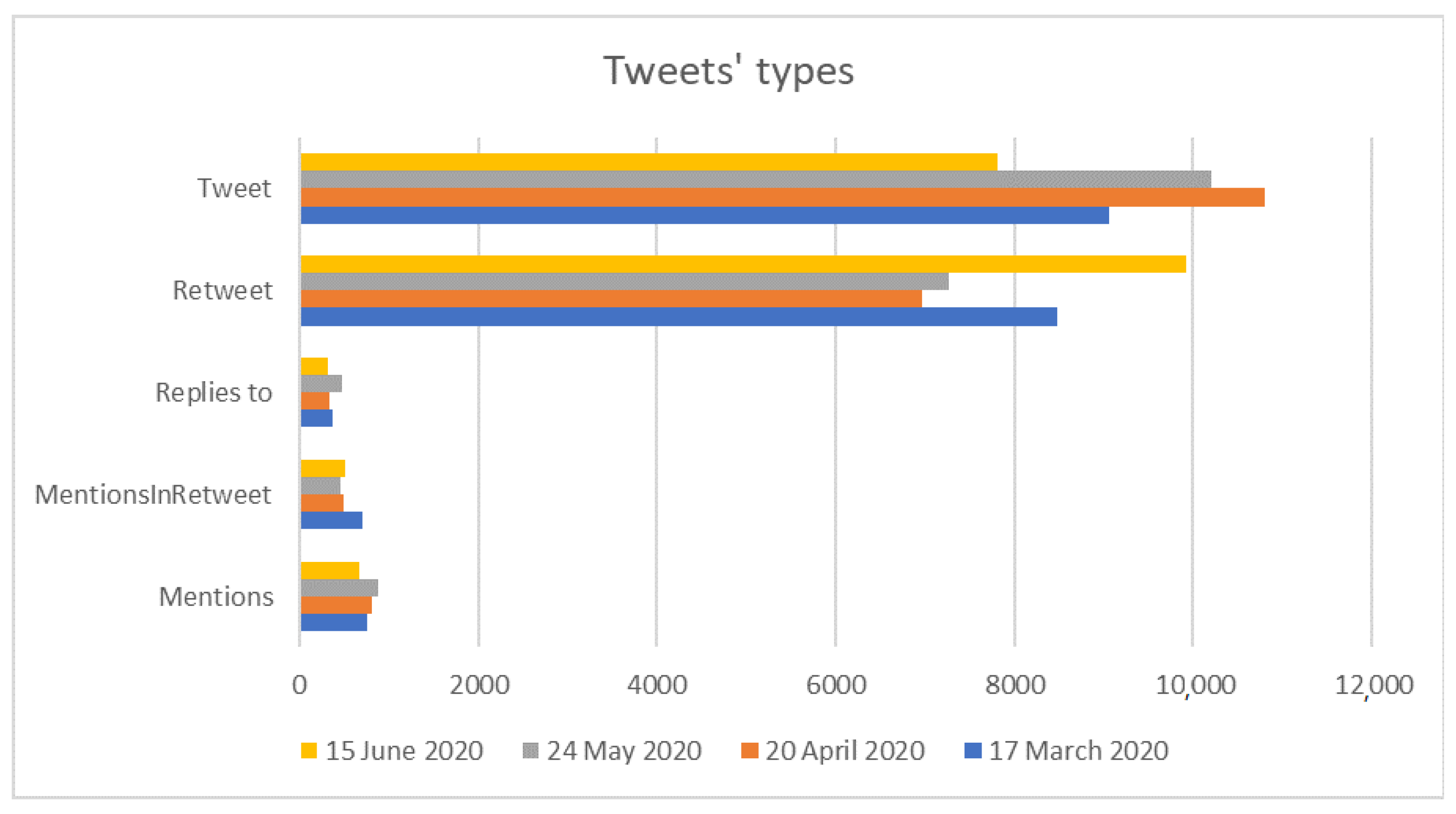
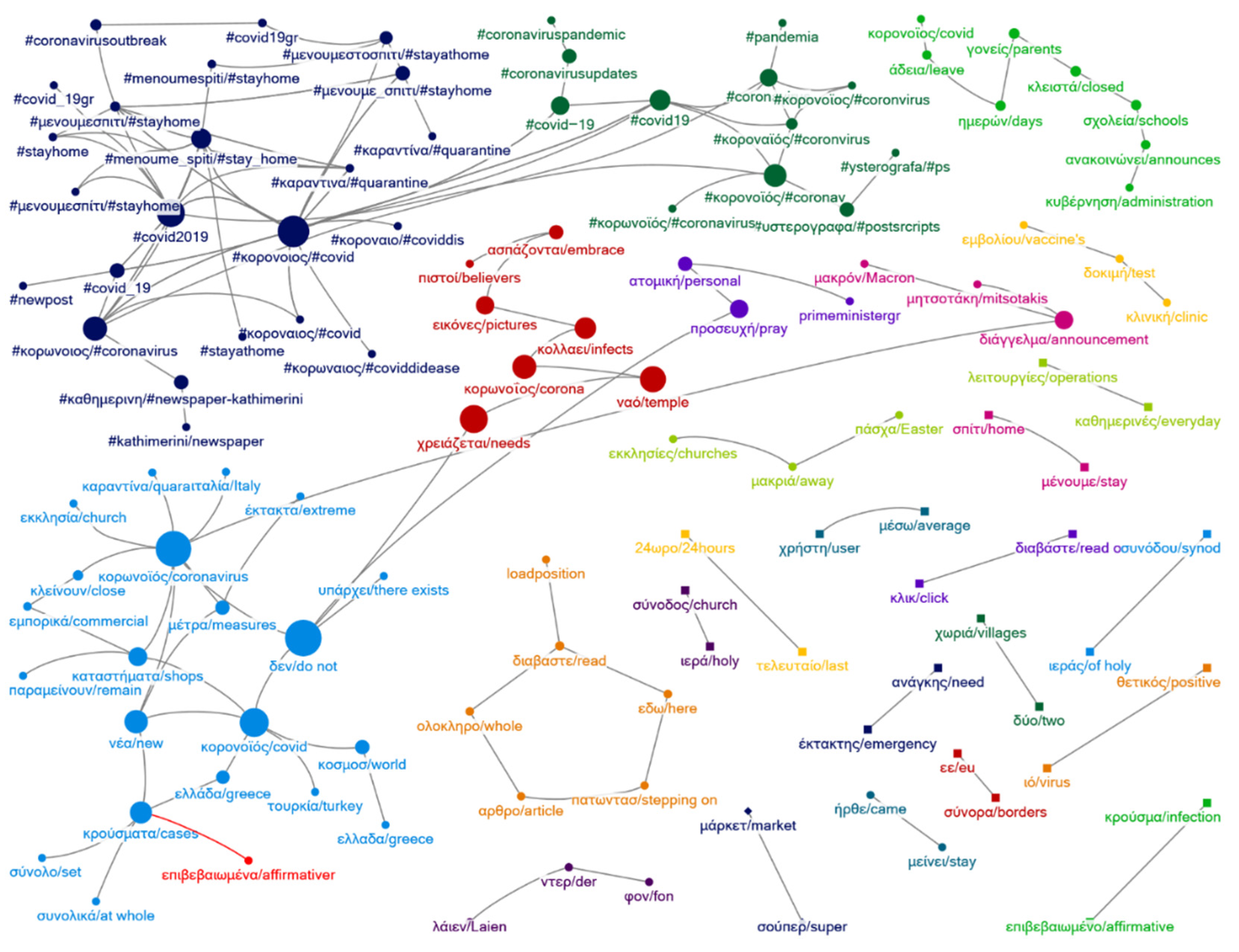
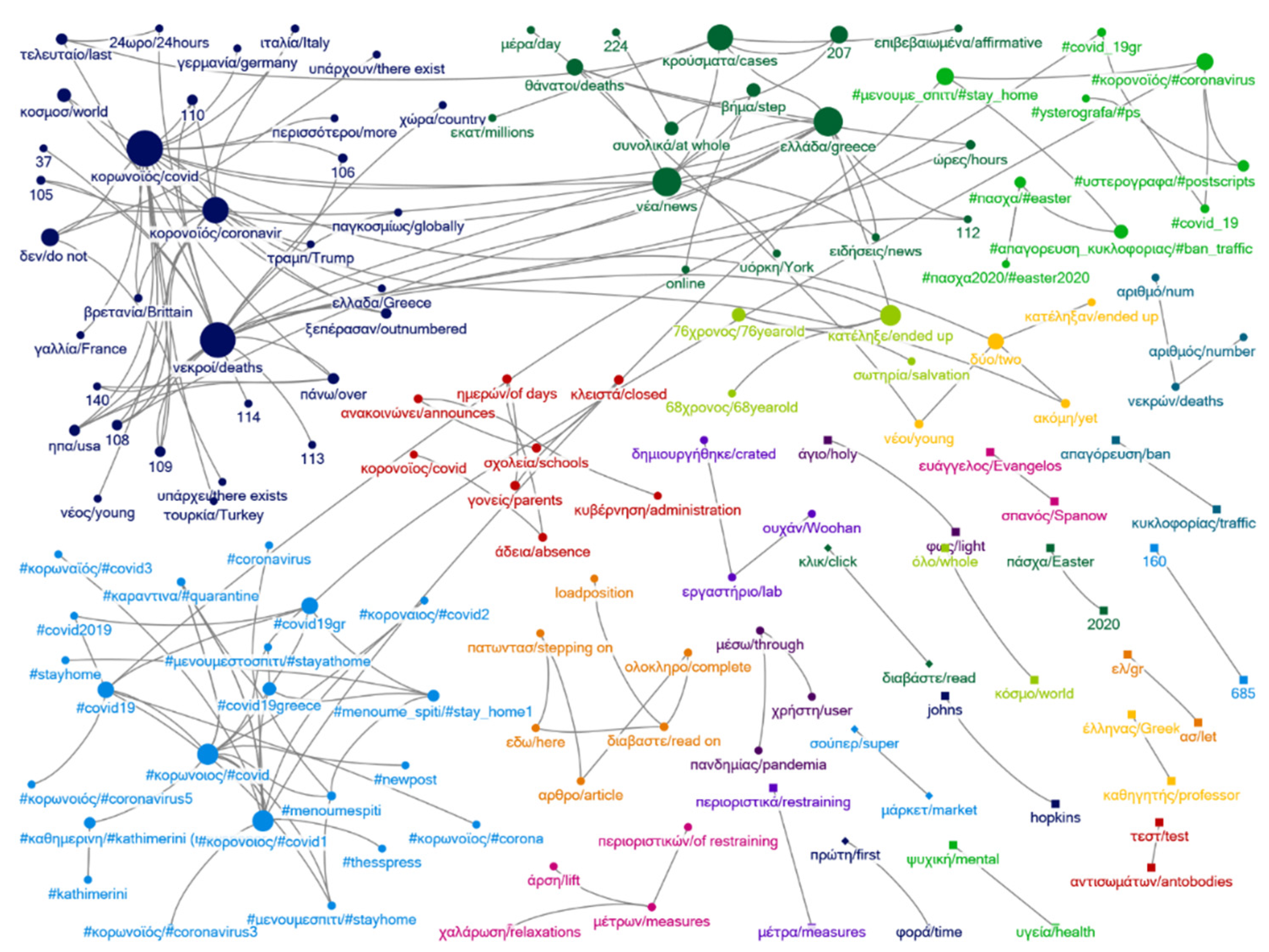
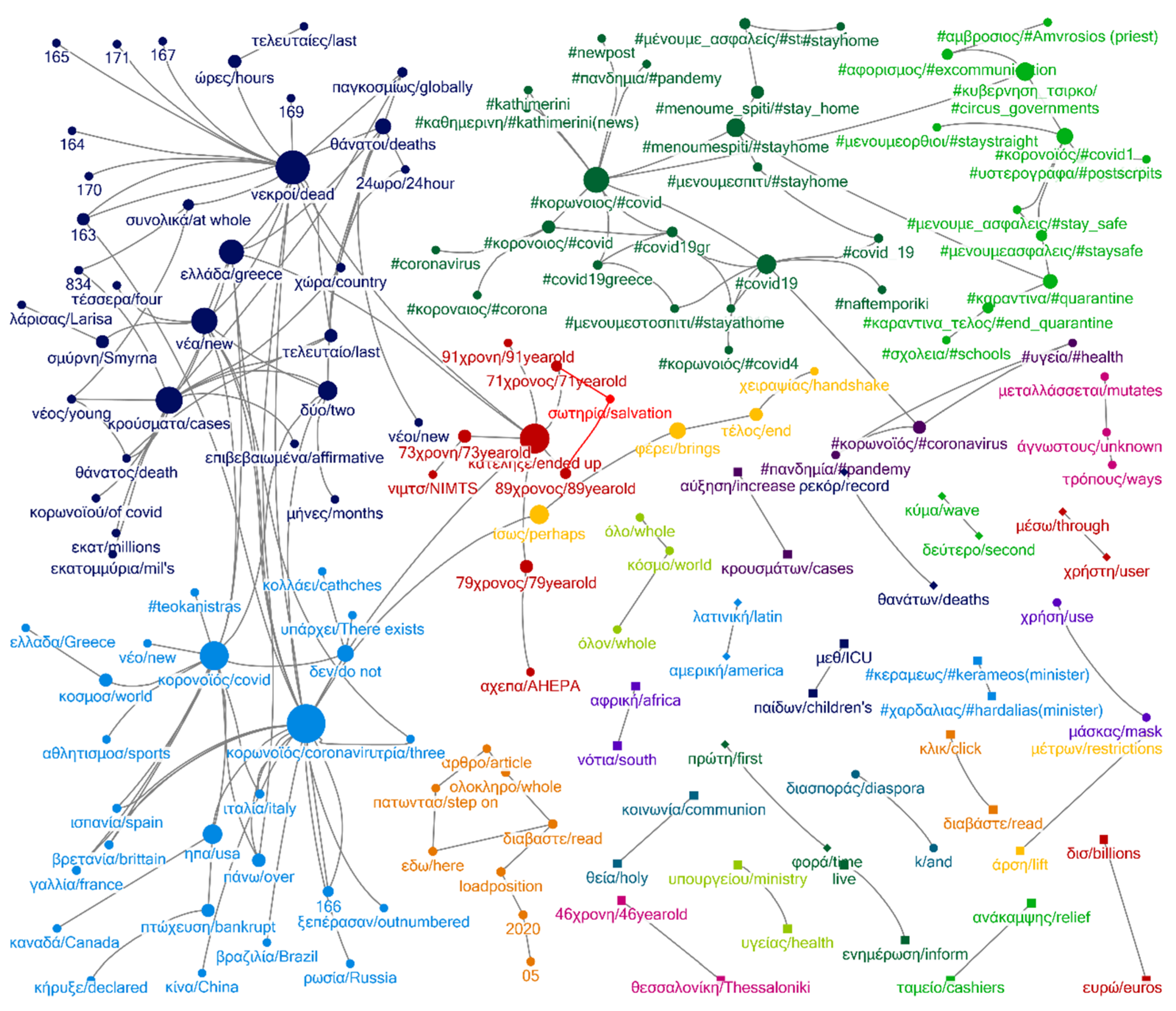
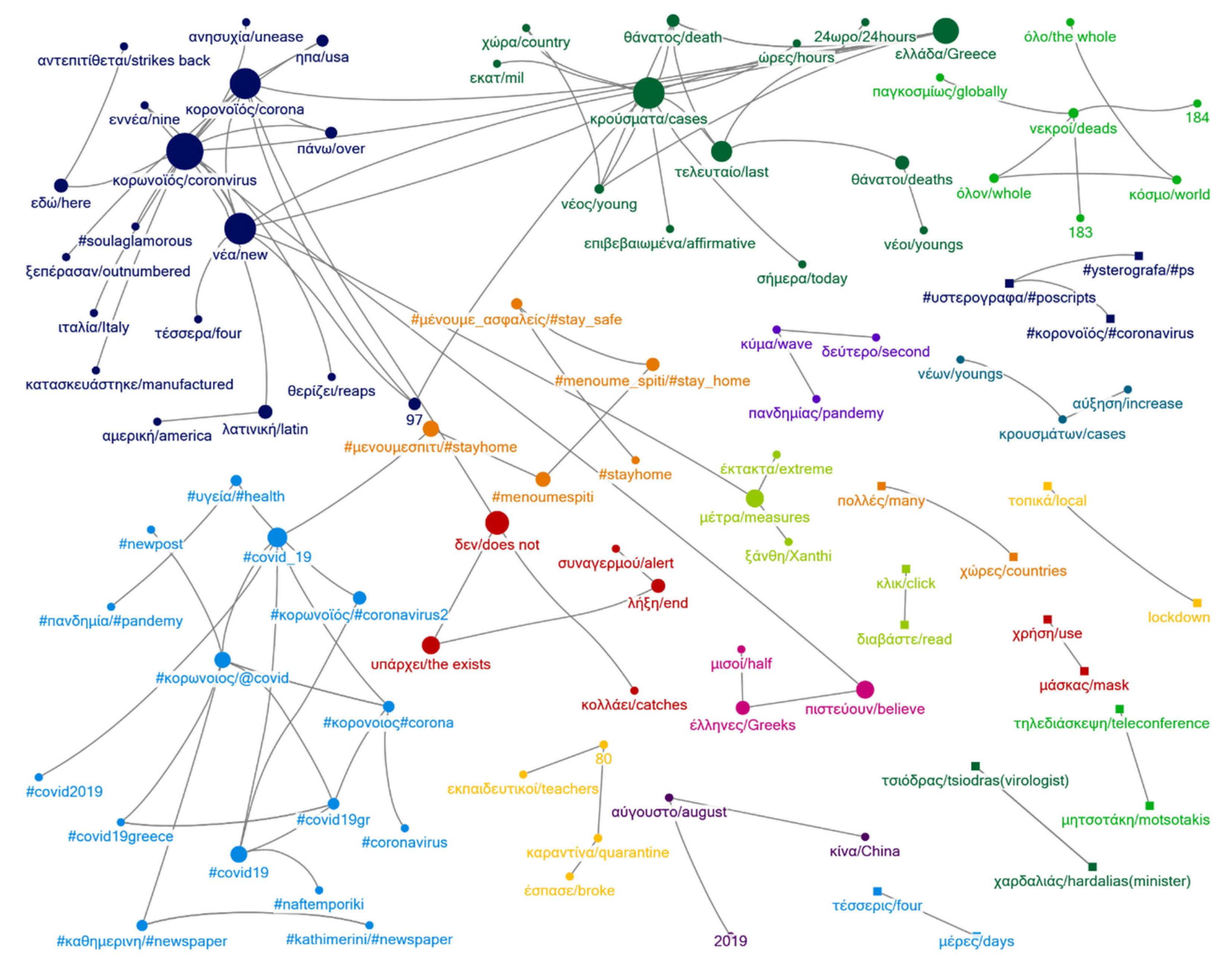
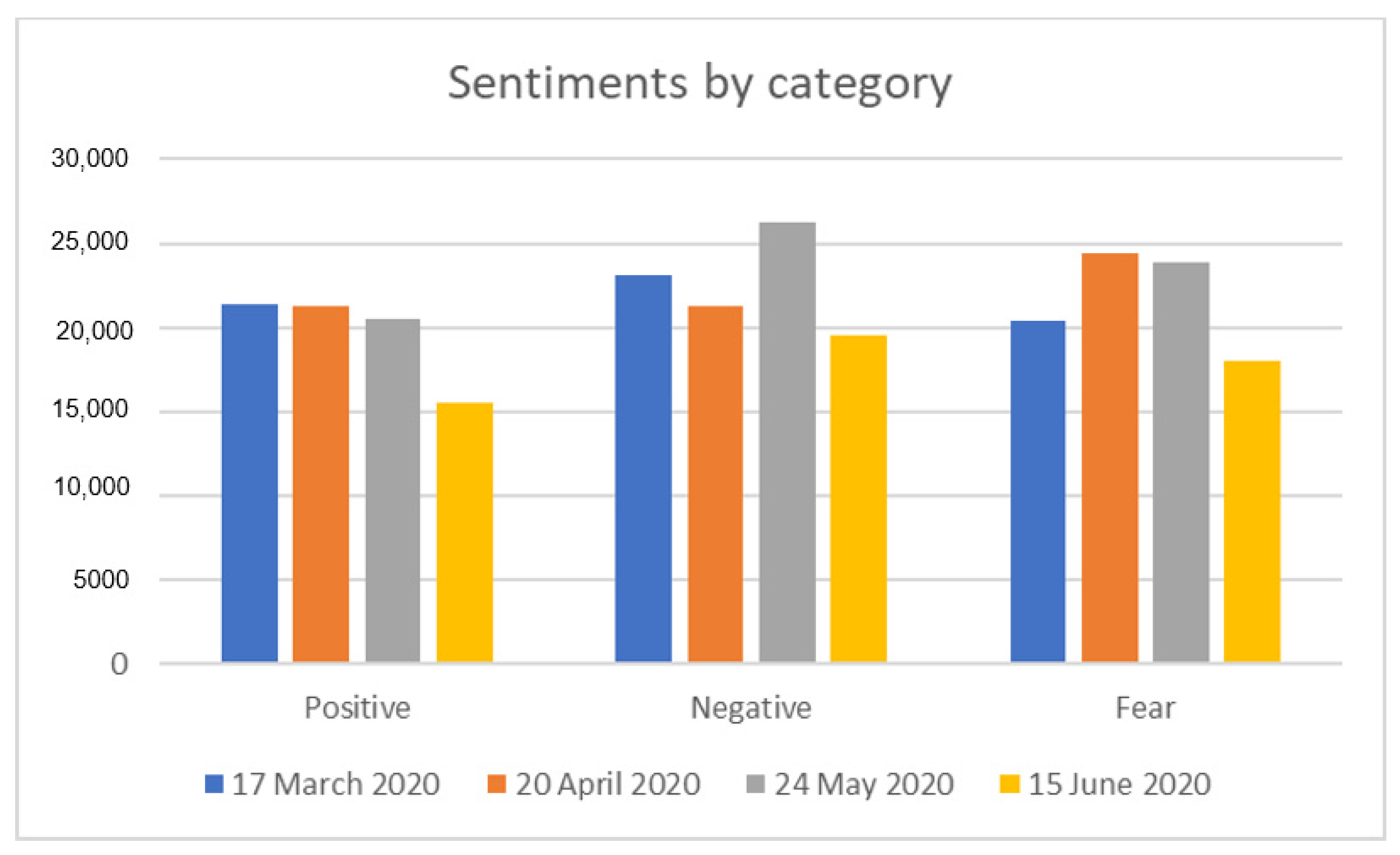
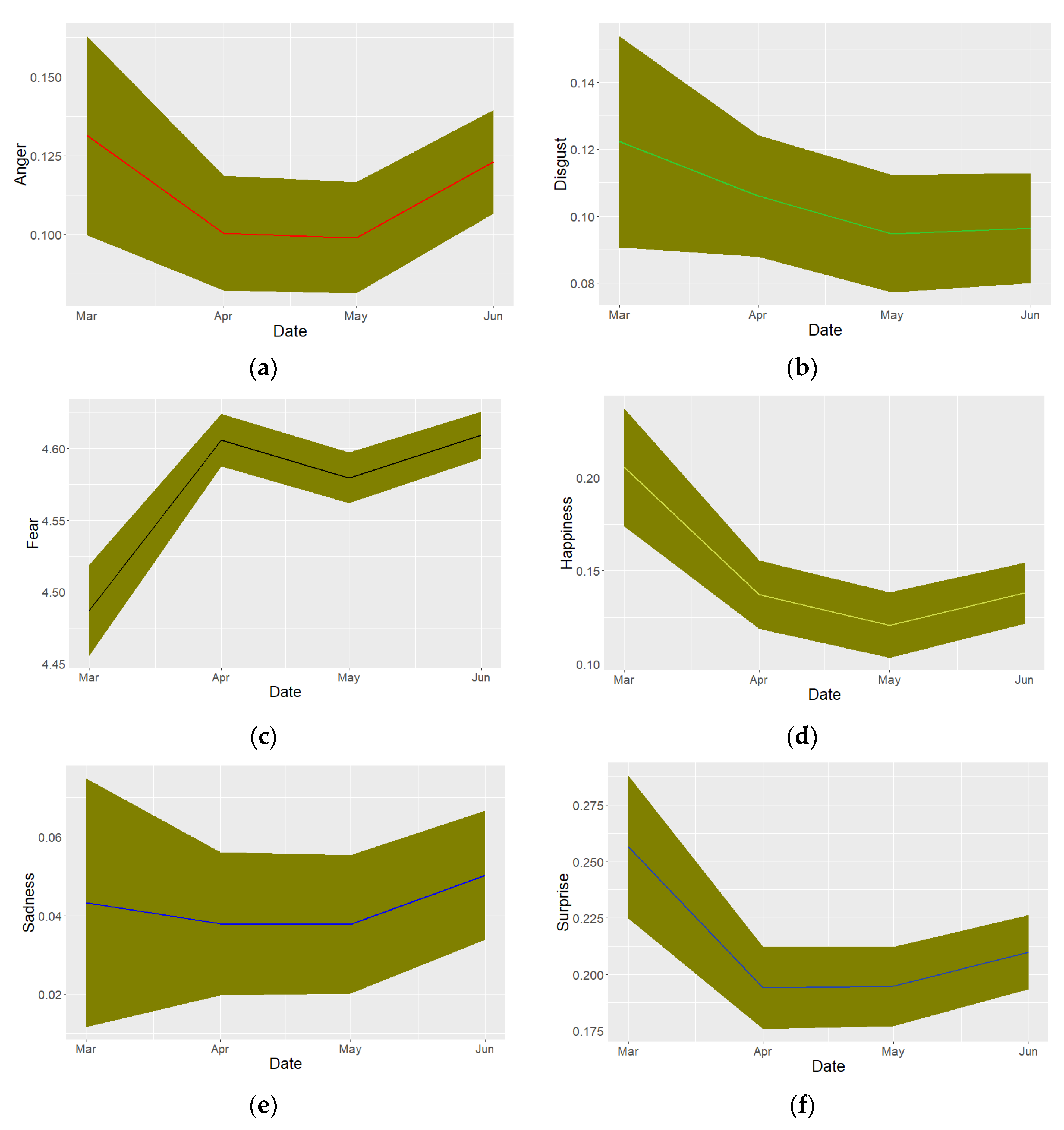
| Tweets’ Type | 17 March 2020 | 20 April 2020 | 24 May 2020 | 15 June 2020 |
|---|---|---|---|---|
| Mentions | 747 | 805 | 875 | 671 |
| MentionsInRetweet | 711 | 493 | 453 | 502 |
| Replies to | 363 | 334 | 478 | 321 |
| Retweet | 8475 | 6967 | 7275 | 9925 |
| Tweet | 9056 | 10,814 | 10,207 | 7809 |
| Total | 19,352 | 19,413 | 19,288 | 19,228 |
| 17 March 2020 | 20 April 2020 | 24 May 2020 | 15 June 2020 | Classes |
|---|---|---|---|---|
| 4775 | 6096 | 6112 | 4145 | 0–2 |
| 4372 | 6230 | 5173 | 3737 | 3–10 |
| 464 | 609 | 531 | 346 | 11–30 |
| 83 | 82 | 79 | 52 | 31–50 |
| 51 | 66 | 58 | 36 | 51–100 |
| 10 | 15 | 36 | 15 | 101–1500 |
| 17 March 2020 | 20 April 2020 | ||||
| Νέα/New | Κρούσματα/Cases | 267 | Νέα/New | Κρούσματα/cases | 663 |
| Σούπερ/super | Μάρκετ/Market | 182 | Νέοι/New | Θάνατοι/deaths | 312 |
| Μέσο/average | Χρήστη/User | 177 | Νεκροί/Dead | Ελλάδα/Greece | 272 |
| #covid_19 | #covid2019 | 130 | 108 | Νεκροί//dead | 169 |
| Κορωνοϊός/coronavirys | Νέα/new | 128 | Τελευταίο/last | 24ωρο/24 h | 167 |
| #covid2019 | #κορονοιος/#coronavirus | 121 | Κορωνοϊός/coronavirus | Νέα/new | 159 |
| #καραντινα/#quarantine | #κορονοιος/#coronavirus | 117 | #ysterografa/#ps | #υστερογραφα/#ps | 135 |
| Ελλαδα/greece | Κοσμοσ/world | 107 | Ελλαδα/Greece | Κοσμος/World | 130 |
| #menoume_spiti/#stayhome | #κορονοιος/#coronavirus | 98 | Μέσο/Average | Χρήστη/user | 124 |
| #menoume_spiti | #stayhome | 95 | #κορονοϊός/#coronavirus | #μενουμε_σπιτι/#stay_home | 119 |
| 24 May 2020 | 15 June 2020 | ||||
| Νέα/new | Κρούσματα/cases | 1137 | Νέα/New | Κρούσματα/cases | 1062 |
| Κορωνοϊός/coronavirus | Νέα/new | 284 | Κορωνοϊός/Coronavirus | Νέα/new | 342 |
| Τελευταίο/last | 24ωρο/24 h | 275 | Τελευταίο/last | 24ωρο/24 h | 315 |
| #κορονοιος/#coronavirus | #covid19 gr | 267 | Νέος/New | Θάνατος/Death | 259 |
| #covid19 | #covid_19 | 265 | Κρούσματα/Cases | Ελλάδα/Greece | 182 |
| #coronavirus | #κορονοιος/#coronavirus | 261 | Κορονοϊός/coronavirus | Νέα/new | 178 |
| #μενουμεσπιτι/#stayhome | #menoumespiti/#stayhome | 261 | Κρούσματα/cases | Νέος/new | 144 |
| #covid_19 | #μενουμεσπιτι/#stayhome | 259 | Κρούσματα/cases | Θάνατος/death | 144 |
| #menoumespiti/#stayhome | #menoume_spiti | 259 | Θάνατος/death | Τελευταίο/last | 140 |
| #menoume_spiti/#stay_home | #stay_safe | 259 | #ysterografa/#ps | #υστερογραφα/#ps | 124 |
| 17 March 2020 | 20 April 2020 | 24 May 2020 | 15 June 2020 | ||||
|---|---|---|---|---|---|---|---|
| Nodes | 121 | Nodes | 144 | Nodes | 158 | Nodes | 99 |
| Links | 145 | Links | 172 | Links | 185 | Links | 106 |
| Components | 21 | Components | 23 | Components | 24 | Components | 15 |
| Diameter | 11 | Diameter | 7 | Diameter | 8 | Diameter | 9 |
| Aver. Shortest Path | 3.33 | Aver. Shortest Path | 2.9 | Aver. Shortest Path | 3.33 | Aver. Shortest Path | 3.37 |
| Density | 0.009 | Density | 0.016 | Density | 0.014 | Density | 0.02 |
| Modularity | 0.69 | Modularity | 0.7 | Modularity | 0.71 | Modularity | 0.73 |
| 17 March 2020 | 20 April 2020 | 24 May 2020 | 15 June 2020 |
|---|---|---|---|
| Δεν/do not | Κορωνοϊός/coronavirus | Κορωνοϊός/coronavirus | Κορωνοϊός/coronavirus |
| Κορωνοϊός/coronavirus | Νεκροί/dead | Νεκροί/dead | Νέα/new |
| #κορονοιος/#coronavirus | Ελλάδα/Greece | Κατέληξε/died | Κρούσματα/cases |
| Κορονοϊός/corona | Νέα/New | Κορονοϊός/covid | Κορονοϊός/corona |
| Χρειάζεται/needs | Κορονοϊός/covid | Κρούσματα/cases | Ελλάδα/Greece |
| #covid2019 | Κρούσματα/cases | Νέα/new | Δεν/do not |
| Ναό/temple | #κορονοιος/#covid | #κορωνοιος/#covid | Τελευταίο/last |
| #κορωνοιος/#corona | #κορωνοιος/#corona | Ελλάδα/Greece | #covid_19 |
| Κορωνοΐος/#covid | Κατέληξε/died | ηπα/USA | Μέτρα/measures |
| Νέα/new | Δεν/de not | #covid19 | Υπάρχει/there exists |
| 17 March 2020 | 20 April 2020 | 24 May 2020 | 15 June 2020 |
|---|---|---|---|
| Σούπερ/super | Κλικ/click | Μέσο/average | Κλικ/click |
| Μάρκετ/market | Διαβάστε/read | Χρήστη/user | Διαβάστε/read |
| Μέσo/average | Σούπερ/super | Δεύτερο/second | Τοπικά/local |
| Χρήστη/user | Μάρκετ/market | Κύμα/wave | Lockdown |
| Κλικ/click | Πρώτη/first | Πρώτη/first | Πολλές/many |
| Διαβάστε/read | Φορά/time | Φορά/time | Χώρες/countries |
| Ιερά/holy | Aπαγόρευση/prohibition | Λατινική/latin | Χρήση/use |
| Sentiment | 17 March 2020 | 20 April 2020 | 24 May 2020 | 15 June 2020 |
|---|---|---|---|---|
| Positive | 21,329 | 21,326 | 20,461 | 15,496 |
| Negative | 23,070 | 21,326 | 26,309 | 19,566 |
| Fear | 20,385 | 24,431 | 23,871 | 18,073 |
| Non-Categorized | 125,805 | 144,649 | 136,004 | 100,143 |
| Total words | 158,956 | 177,753 | 171,503 | 126,992 |
| Date | Anger | Disgust | Fear | Happiness | Sadness | Surprise | Polarity |
|---|---|---|---|---|---|---|---|
| March-2020 | 0.131476 | 0.122283 | 4.487119 | 0.205658 | 0.043271 | 0.256531 | 0.031635 |
| April-2020 | 0.100473 | 0.105995 | 4.605822 | 0.137242 | 0.037904 | 0.194033 | 0.018211 |
| May-2020 | 0.098979 | 0.094727 | 4.579573 | 0.120884 | 0.037775 | 0.194678 | 0.017574 |
| June-2020 | 0.123149 | 0.096447 | 4.609404 | 0.138101 | 0.050227 | 0.209887 | 0.016401 |
Publisher’s Note: MDPI stays neutral with regard to jurisdictional claims in published maps and institutional affiliations. |
© 2021 by the authors. Licensee MDPI, Basel, Switzerland. This article is an open access article distributed under the terms and conditions of the Creative Commons Attribution (CC BY) license (https://creativecommons.org/licenses/by/4.0/).
Share and Cite
Kydros, D.; Argyropoulou, M.; Vrana, V. A Content and Sentiment Analysis of Greek Tweets during the Pandemic. Sustainability 2021, 13, 6150. https://doi.org/10.3390/su13116150
Kydros D, Argyropoulou M, Vrana V. A Content and Sentiment Analysis of Greek Tweets during the Pandemic. Sustainability. 2021; 13(11):6150. https://doi.org/10.3390/su13116150
Chicago/Turabian StyleKydros, Dimitrios, Maria Argyropoulou, and Vasiliki Vrana. 2021. "A Content and Sentiment Analysis of Greek Tweets during the Pandemic" Sustainability 13, no. 11: 6150. https://doi.org/10.3390/su13116150
APA StyleKydros, D., Argyropoulou, M., & Vrana, V. (2021). A Content and Sentiment Analysis of Greek Tweets during the Pandemic. Sustainability, 13(11), 6150. https://doi.org/10.3390/su13116150







